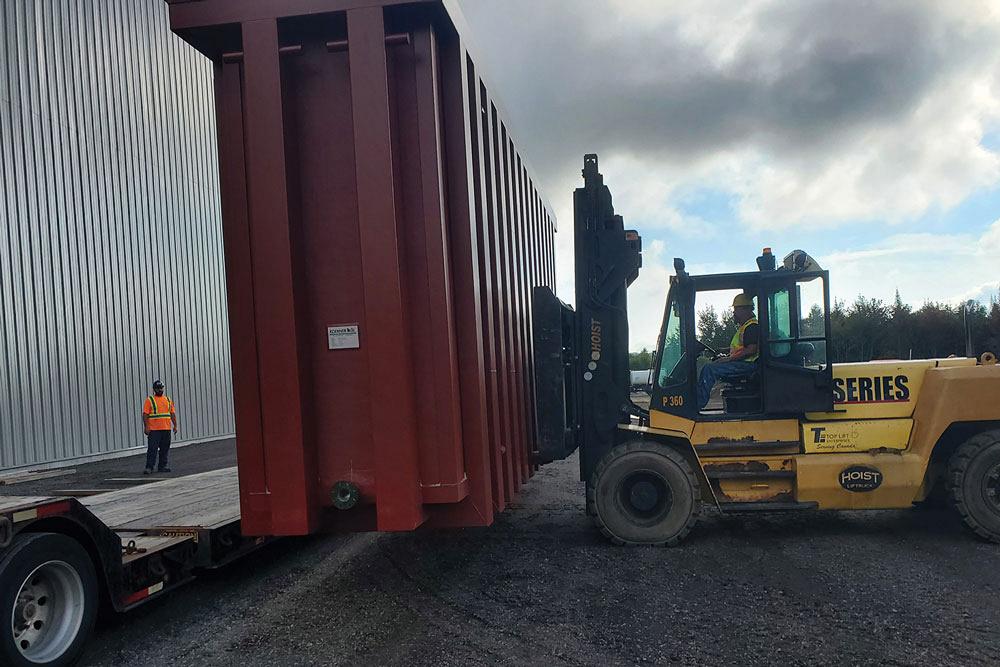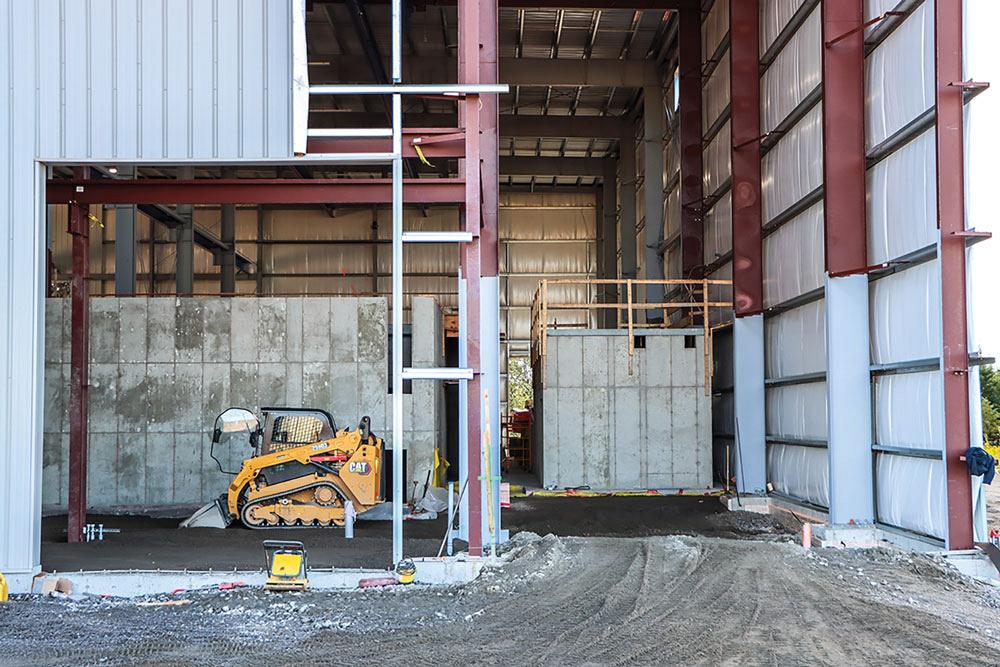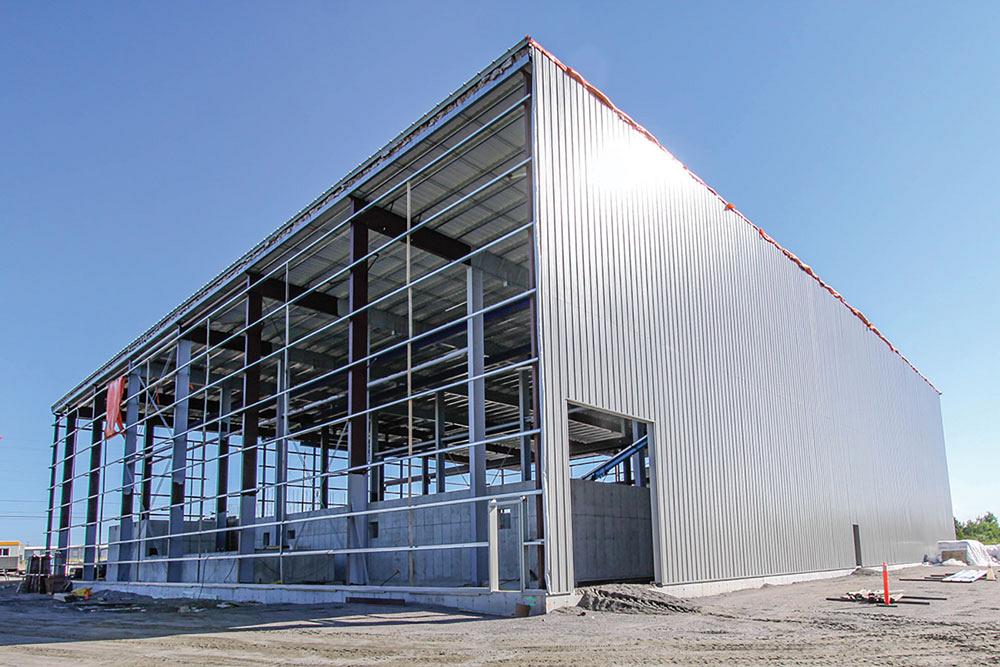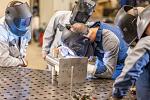Editor
- FMA
- The Fabricator
- FABTECH
- Canadian Metalworking
Galvanizing plant set to open in North Bay
New business opens opportunities for local fabricators
- By Rob Colman
- Updated October 13, 2020
- October 13, 2020
- Article
- Fabricating

Designed by specialists from Austria and Germany at Koerner KVK, the Norgalv facility will be a semi-automated, single-line hot-dipped galvanizing plant. Here the first Koerner KVK pre-treatment tank is being delivered from Austria.
In August construction of a new galvanizing plant in North Bay, Ont., reached a milestone with the pouring of the facility’s 35,000-sq.-ft. concrete floor. Despite delays arising from the COVID-19 pandemic, the plant should be up and running by the end of the year. The Norgalv Ltd. plant aims to serve the galvanizing needs of Northern Ontario companies and those farther afield and expects to employ around 45 people in North Bay.
Norgalv was created by the shareholders of a group of galvanizing plants in South Africa who researched global opportunities for expansion.
“We have had a lot of support for this project from Canada’s federal and provincial governments,” said Andre van Soelen, managing director of Norgalv. “And when it came to choosing a city-specific site, North Bay was streets ahead of everyone else in being accommodating and helping to make this happen.”
Local Value
Norgalv’s goal is to serve Northern Ontario’s mining supply and service industry, although van Soelen believes the quality of the company’s product and processes will draw customers from farther away and create fabrication opportunities in and around North Bay itself.
“There isn’t another galvanizing plant in Northern Ontario, so certain products like scaffolding aren’t produced locally,” said van Soelen. “It just wouldn’t be worth manufacturing a product like that here if you had to ship it south for processing. Now that Norgalv is here, fabricators can expand their business options here and potentially look to ship finished product across the country and beyond.” Van Soelen pointed out that many other sectors require hot-dip galvanizing, including telecommunications, road infrastructure, agricultural, petroleum, and power generation.
Both Norgalv and the city of North Bay see the opportunity for more industrial development in the area. The company benefited from the city’s first industrial incentive program known as the Airport Community Improvement Plan (ACIP). The ACIP offered the following incentives: a municipal fee rebate program, a tax assistance program (three-year rebate), and a landfill tipping fee reduction. The ACIP program has sunset, but the incentive program helped support eight new construction projects and one business expansion. Building on the success of the program, the city recently adopted a replacement city-wide plan that extends industrial incentives beyond the ACIP to appropriate properties throughout the community. The value of the savings brought about by this program for Norgalv is around $700,000.
The project, which represents a $21 million investment, is also being supported by the federal and provincial governments. The federal government is contributing $1.5 million through FedNor, and the province is investing $5 million.
Tech Benefits
Designed by specialists from Austria and Germany at Koerner KvK, the Norgalv facility will be a semi-automated, single-line hot-dipped galvanizing plant with an 8- by 1.4- by 3.5-m "kettle" and all other supplementary equipment required.

Despite delays caused by the pandemic, the facility should be up and running by the end of the year. This is a view of the dryer and scrubber system during construction.
Management at the company has been keen to tout the advanced, environmentally friendly nature of the technology being used, which, according to van Soelen, exceeds strict European emissions requirements.
“In new galvanizing plants we install all state-of-the-art equipment,” said Manfred Schell, sales director, Koerner KvK. “The complete pretreatment process is enclosed so that no acidic fumes can escape into the environment. The acidic fumes, meanwhile, are washed continuously in a scrubber to fulfill the most stringent regulations. In addition, the zinc kettle itself is enclosed and the so-called ‘white fumes’ generated in the galvanizing process are collected and filtered in a zinc dust filter.”
All floors in the company’s handling area for acids are acid-proof-coated to eliminate the risk of these entering the ground.
The key to the advanced safety provisions of the facility is limiting human contact with products in the process.
After manual rigging of the material on a lifting/lowering station, the jig with the material to be galvanized is moved with a manual overhead crane onto a manual shuttle in front of the pre-treatment area. Once on the shuttle, the material is driven manually into the pre-treatment station.
At the pretreatment station, the operator starts the automated process. The operator assigns a recipe (defining a process sequence that includes immersion times and dipping routines) and parts are rolled automatically into the pre-treatment process. No handling is done once this pickling process starts.
At the end of the enclosed pickling area, the crane puts the jig automatically on a chain conveyor in the dryer. The chain conveyor in the dryer then transfers the jig out of the pre-treatment area to the furnace area within the dryer.
At the last position of the chain conveyor in the dryer, a crane picks up the jig from the chain conveyor and moves it to the zinc bath.
The galvanizing process itself is controlled manually. After galvanizing, the crane moves the galvanized steel to a buffer area. The buffer area and the unrigging is a manual process.
Safety Keys

The facility is 35,000 sq. ft. This perspective of the building shows the acid delivery entrance before completion of the exterior wall.
The automatic processing in the pickling area ensures a continuous work flow, which increases the efficiency of the facility compared to older galvanizing facilities. It also ensures more reliable consistency in the final product.
In addition, having the pickling area completely enclosed means that acidic fumes are contained and no one is exposed unnecessarily. All fumes from both the pickling area and the zinc kettle are carefully filtered to ensure none are released inside or outside the facility.
Automated crane areas, meanwhile, are enclosed with fencing so that workers aren’t at risk of being injured by moving material.
Another way Norgalv will be safeguarding not only their employees but also the environment is with a completely chromium-free passivation product that will produce a high-quality finish on all galvanized work. Hexavalent chromium has been shown time and time again to be dangerous and persistent environmental pollutant that is highly toxic and carcinogenic.
TIB Chemicals AG from Germany will supply Norgalv with its TIB Finish Polycoat. Andrew Bennison, TIB´s technical consultant for hot dip galvanizing said, “The toxic hexavalent chromium has been replaced with non-toxic zirconium - the most corrosion-resilient metal on the planet. This, together with the same polymers found in children’s glue, PVA, will provide an environmentally sound temporary protection from white rust and corrosion.”
Wastewater produced by the process will be reused in the facility.
Quality control will follow specific guidelines.
“Norgalv will strictly adhere to the ASTM A123 standard for hot-dip galvanizing to assure a quality finish with the optimal thickness level of the zinc coating,” said van Soelen. “More importantly, Norgalv is establishing a culture at its operation that truly respects the steel products that our customers send to us. Everything we receive will be carefully inspected before and after galvanizing to assure that the end product doesn’t merely meet the technical standard, but reflects and enhances the care and craftsmanship that the manufacturer invested in making it.”
While van Soelen said there are already a number of businesses Norgalv will be serving locally, he also believes that there are opportunities for further growth in North Bay for fabricators.
“We can create a more diverse economy here,” he said. “I think it will get easier to recruit people to the north as more people understand the benefits of living in a smaller community with access to infrastructure that allows them to market products across the country and beyond.”

Much of the processing will be automated, like this automatic trolley line for which foundations are being installed.
Editor Robert Colman can be reached at rcolman@canadianfabweld.com.
Norgalv Ltd., norgalv.ca
About the Author

Rob Colman
1154 Warden Avenue
Toronto, M1R 0A1 Canada
905-235-0471
Robert Colman has worked as a writer and editor for more than 25 years, covering the needs of a variety of trades. He has been dedicated to the metalworking industry for the past 13 years, serving as editor for Metalworking Production & Purchasing (MP&P) and, since January 2016, the editor of Canadian Fabricating & Welding. He graduated with a B.A. degree from McGill University and a Master’s degree from UBC.
subscribe now


Keep up to date with the latest news, events, and technology for all things metal from our pair of monthly magazines written specifically for Canadian manufacturers!
Start Your Free Subscription- Trending Articles
Class is in session for college connections

BlueForge Alliance partners with Nuts, Bolts & Thingamajigs to develop Submarine Manufacturing Camps

Engine-driven welding machines include integrated air compressors

Orbital tube welding webinar to be held April 23

Portable system becomes hot tech in heat treatment

- Industry Events
ZEISS Quality Innovation Days 2024
- April 15 - 19, 2024
Tube 2024
- April 15 - 19, 2024
- Düsseldorf, Germany
CTMA Economic Uncertainty: Helping You Navigate Windsor Seminar
- April 30, 2024
- Windsor, ON Canada
MME Winnipeg
- April 30, 2024
- Winnipeg, ON Canada
CTMA Economic Uncertainty: Helping You Navigate Kitchener Seminar
- May 2, 2024
- Kitchener, ON Canada
















